Analyzing Variable Pay Schemes and Impact on Motivational Theories
VerifiedAdded on 2023/04/25
|21
|5206
|72
Report
AI Summary
This report critically examines the role of variable pay schemes in motivating employees, analyzing their impact on both intrinsic and extrinsic motivation. It explores the relationship between pay variables and employee motivation, referencing common pay schemes such as individual sales commissions, bonuses, and merit-based payouts. The report also delves into Maslow’s Hierarchy of Needs and Herzberg’s Two-Factor Theory to provide a theoretical framework for understanding employee motivation. Challenges in implementing variable pay schemes are discussed, followed by recommendations for organizations to structure their incentive plans more effectively to enhance employee performance and retention. This document is available on Desklib, a platform offering a wide array of study resources for students.
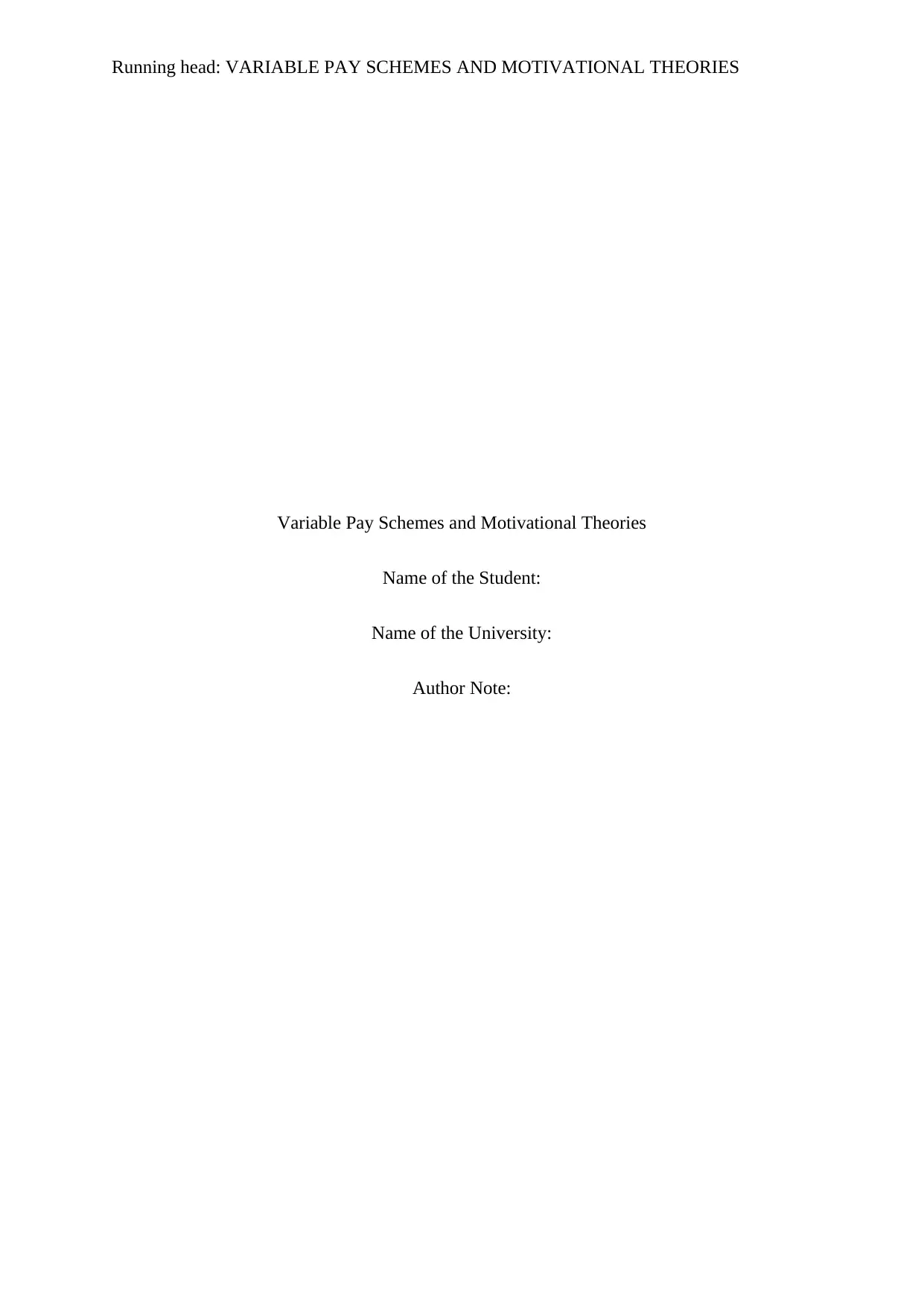
Running head: VARIABLE PAY SCHEMES AND MOTIVATIONAL THEORIES
Variable Pay Schemes and Motivational Theories
Name of the Student:
Name of the University:
Author Note:
Variable Pay Schemes and Motivational Theories
Name of the Student:
Name of the University:
Author Note:
Paraphrase This Document
Need a fresh take? Get an instant paraphrase of this document with our AI Paraphraser
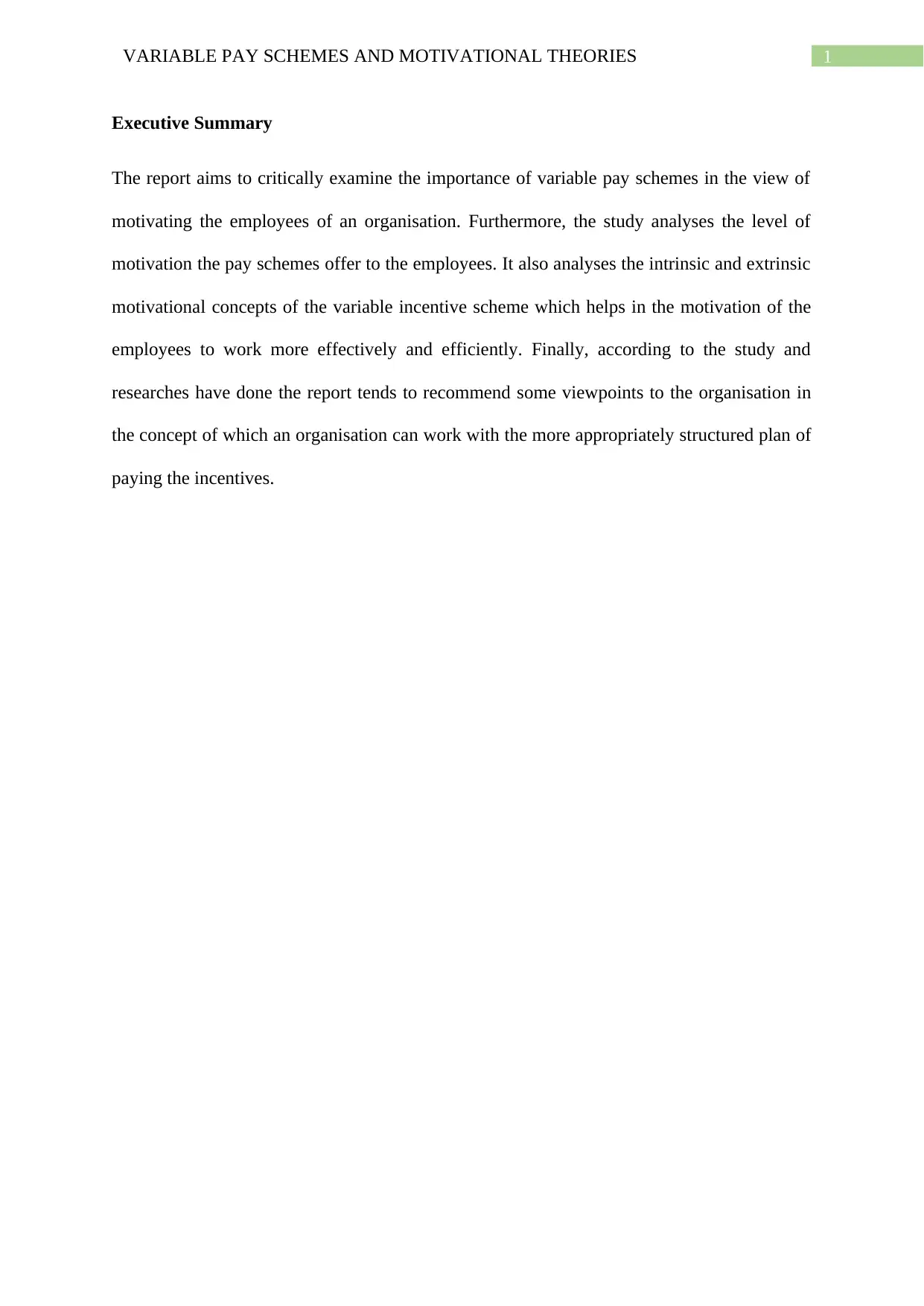
1VARIABLE PAY SCHEMES AND MOTIVATIONAL THEORIES
Executive Summary
The report aims to critically examine the importance of variable pay schemes in the view of
motivating the employees of an organisation. Furthermore, the study analyses the level of
motivation the pay schemes offer to the employees. It also analyses the intrinsic and extrinsic
motivational concepts of the variable incentive scheme which helps in the motivation of the
employees to work more effectively and efficiently. Finally, according to the study and
researches have done the report tends to recommend some viewpoints to the organisation in
the concept of which an organisation can work with the more appropriately structured plan of
paying the incentives.
Executive Summary
The report aims to critically examine the importance of variable pay schemes in the view of
motivating the employees of an organisation. Furthermore, the study analyses the level of
motivation the pay schemes offer to the employees. It also analyses the intrinsic and extrinsic
motivational concepts of the variable incentive scheme which helps in the motivation of the
employees to work more effectively and efficiently. Finally, according to the study and
researches have done the report tends to recommend some viewpoints to the organisation in
the concept of which an organisation can work with the more appropriately structured plan of
paying the incentives.
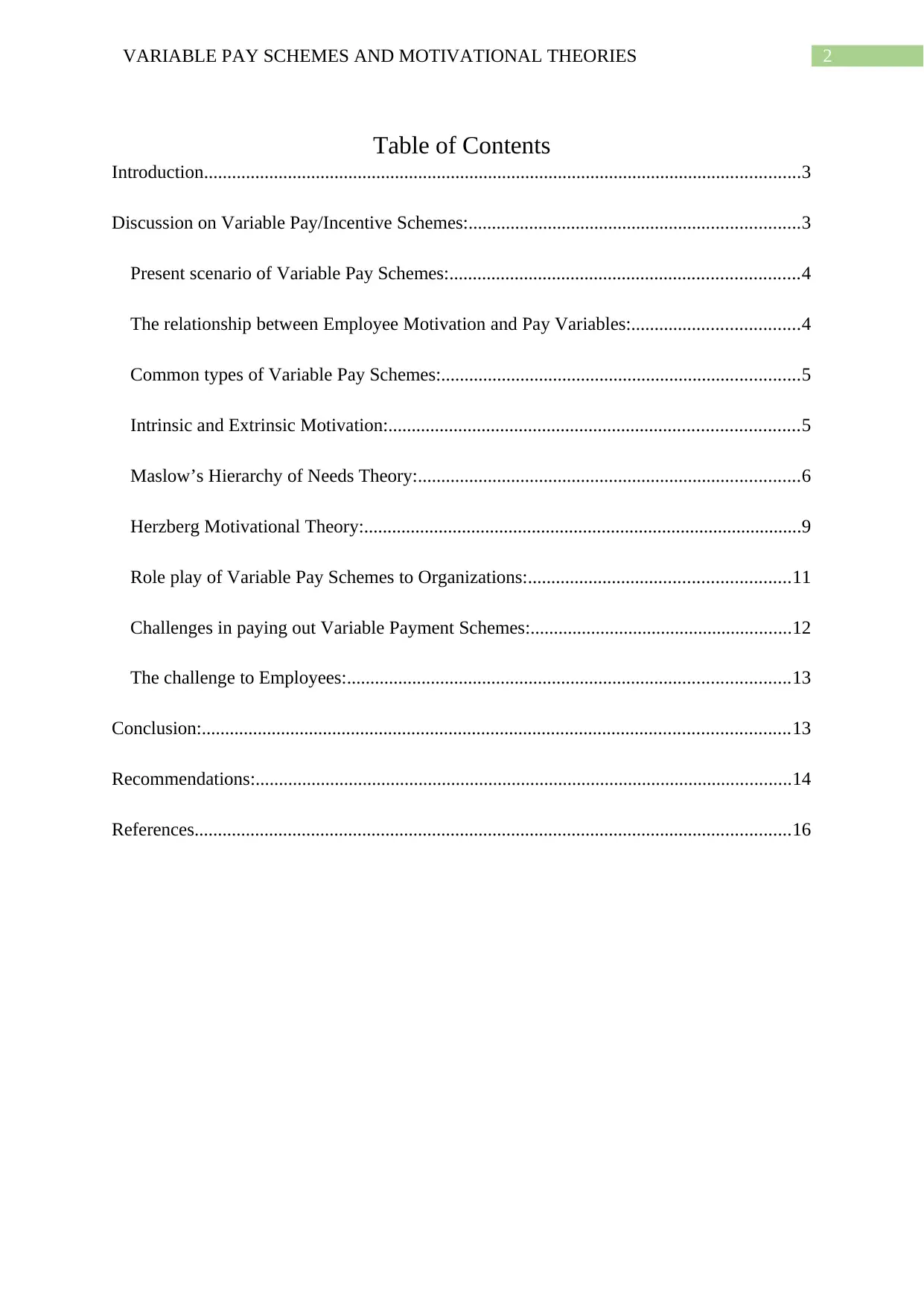
2VARIABLE PAY SCHEMES AND MOTIVATIONAL THEORIES
Table of Contents
Introduction................................................................................................................................3
Discussion on Variable Pay/Incentive Schemes:.......................................................................3
Present scenario of Variable Pay Schemes:...........................................................................4
The relationship between Employee Motivation and Pay Variables:....................................4
Common types of Variable Pay Schemes:.............................................................................5
Intrinsic and Extrinsic Motivation:........................................................................................5
Maslow’s Hierarchy of Needs Theory:..................................................................................6
Herzberg Motivational Theory:..............................................................................................9
Role play of Variable Pay Schemes to Organizations:........................................................11
Challenges in paying out Variable Payment Schemes:........................................................12
The challenge to Employees:...............................................................................................13
Conclusion:..............................................................................................................................13
Recommendations:...................................................................................................................14
References................................................................................................................................16
Table of Contents
Introduction................................................................................................................................3
Discussion on Variable Pay/Incentive Schemes:.......................................................................3
Present scenario of Variable Pay Schemes:...........................................................................4
The relationship between Employee Motivation and Pay Variables:....................................4
Common types of Variable Pay Schemes:.............................................................................5
Intrinsic and Extrinsic Motivation:........................................................................................5
Maslow’s Hierarchy of Needs Theory:..................................................................................6
Herzberg Motivational Theory:..............................................................................................9
Role play of Variable Pay Schemes to Organizations:........................................................11
Challenges in paying out Variable Payment Schemes:........................................................12
The challenge to Employees:...............................................................................................13
Conclusion:..............................................................................................................................13
Recommendations:...................................................................................................................14
References................................................................................................................................16
⊘ This is a preview!⊘
Do you want full access?
Subscribe today to unlock all pages.

Trusted by 1+ million students worldwide
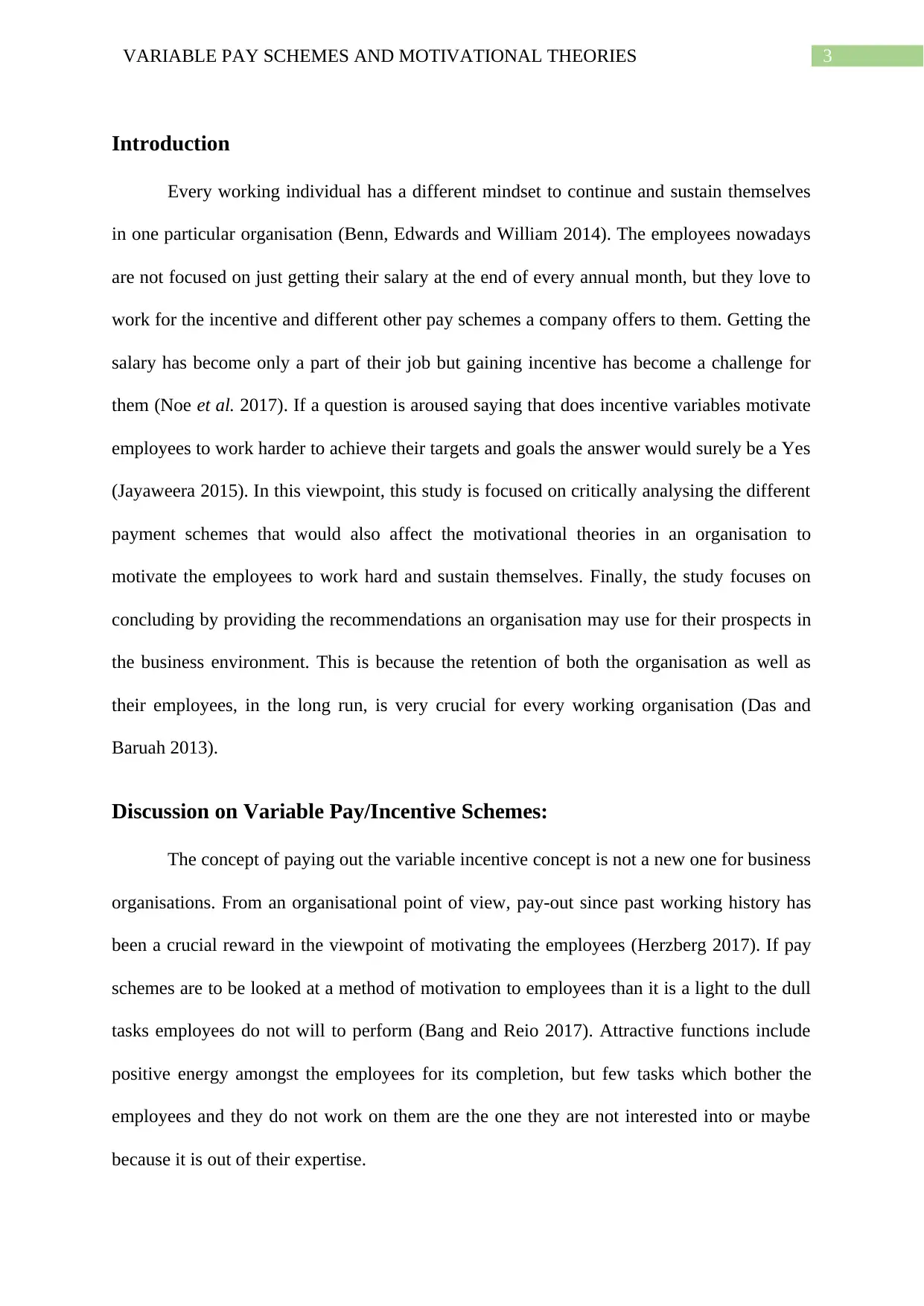
3VARIABLE PAY SCHEMES AND MOTIVATIONAL THEORIES
Introduction
Every working individual has a different mindset to continue and sustain themselves
in one particular organisation (Benn, Edwards and William 2014). The employees nowadays
are not focused on just getting their salary at the end of every annual month, but they love to
work for the incentive and different other pay schemes a company offers to them. Getting the
salary has become only a part of their job but gaining incentive has become a challenge for
them (Noe et al. 2017). If a question is aroused saying that does incentive variables motivate
employees to work harder to achieve their targets and goals the answer would surely be a Yes
(Jayaweera 2015). In this viewpoint, this study is focused on critically analysing the different
payment schemes that would also affect the motivational theories in an organisation to
motivate the employees to work hard and sustain themselves. Finally, the study focuses on
concluding by providing the recommendations an organisation may use for their prospects in
the business environment. This is because the retention of both the organisation as well as
their employees, in the long run, is very crucial for every working organisation (Das and
Baruah 2013).
Discussion on Variable Pay/Incentive Schemes:
The concept of paying out the variable incentive concept is not a new one for business
organisations. From an organisational point of view, pay-out since past working history has
been a crucial reward in the viewpoint of motivating the employees (Herzberg 2017). If pay
schemes are to be looked at a method of motivation to employees than it is a light to the dull
tasks employees do not will to perform (Bang and Reio 2017). Attractive functions include
positive energy amongst the employees for its completion, but few tasks which bother the
employees and they do not work on them are the one they are not interested into or maybe
because it is out of their expertise.
Introduction
Every working individual has a different mindset to continue and sustain themselves
in one particular organisation (Benn, Edwards and William 2014). The employees nowadays
are not focused on just getting their salary at the end of every annual month, but they love to
work for the incentive and different other pay schemes a company offers to them. Getting the
salary has become only a part of their job but gaining incentive has become a challenge for
them (Noe et al. 2017). If a question is aroused saying that does incentive variables motivate
employees to work harder to achieve their targets and goals the answer would surely be a Yes
(Jayaweera 2015). In this viewpoint, this study is focused on critically analysing the different
payment schemes that would also affect the motivational theories in an organisation to
motivate the employees to work hard and sustain themselves. Finally, the study focuses on
concluding by providing the recommendations an organisation may use for their prospects in
the business environment. This is because the retention of both the organisation as well as
their employees, in the long run, is very crucial for every working organisation (Das and
Baruah 2013).
Discussion on Variable Pay/Incentive Schemes:
The concept of paying out the variable incentive concept is not a new one for business
organisations. From an organisational point of view, pay-out since past working history has
been a crucial reward in the viewpoint of motivating the employees (Herzberg 2017). If pay
schemes are to be looked at a method of motivation to employees than it is a light to the dull
tasks employees do not will to perform (Bang and Reio 2017). Attractive functions include
positive energy amongst the employees for its completion, but few tasks which bother the
employees and they do not work on them are the one they are not interested into or maybe
because it is out of their expertise.
Paraphrase This Document
Need a fresh take? Get an instant paraphrase of this document with our AI Paraphraser
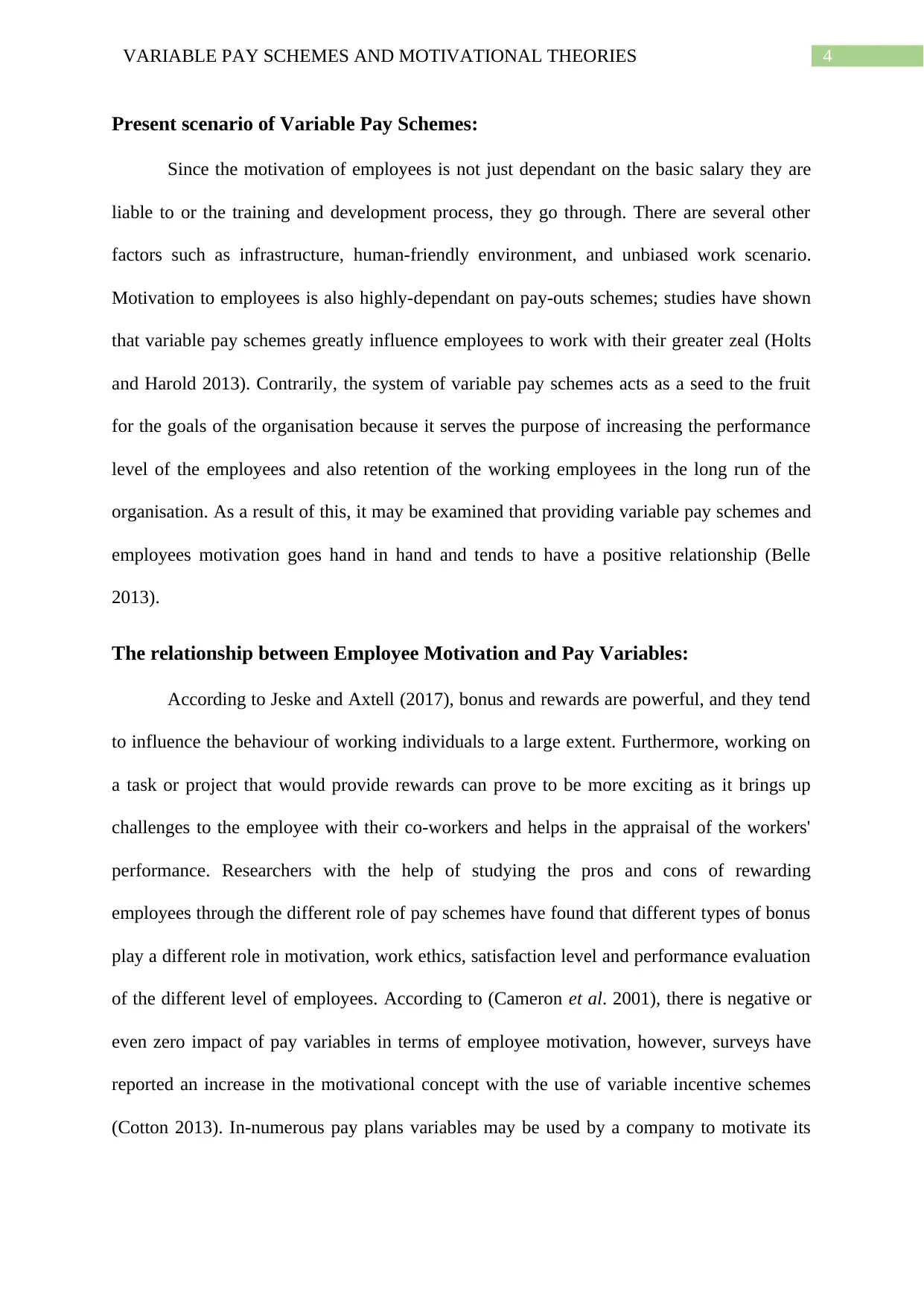
4VARIABLE PAY SCHEMES AND MOTIVATIONAL THEORIES
Present scenario of Variable Pay Schemes:
Since the motivation of employees is not just dependant on the basic salary they are
liable to or the training and development process, they go through. There are several other
factors such as infrastructure, human-friendly environment, and unbiased work scenario.
Motivation to employees is also highly-dependant on pay-outs schemes; studies have shown
that variable pay schemes greatly influence employees to work with their greater zeal (Holts
and Harold 2013). Contrarily, the system of variable pay schemes acts as a seed to the fruit
for the goals of the organisation because it serves the purpose of increasing the performance
level of the employees and also retention of the working employees in the long run of the
organisation. As a result of this, it may be examined that providing variable pay schemes and
employees motivation goes hand in hand and tends to have a positive relationship (Belle
2013).
The relationship between Employee Motivation and Pay Variables:
According to Jeske and Axtell (2017), bonus and rewards are powerful, and they tend
to influence the behaviour of working individuals to a large extent. Furthermore, working on
a task or project that would provide rewards can prove to be more exciting as it brings up
challenges to the employee with their co-workers and helps in the appraisal of the workers'
performance. Researchers with the help of studying the pros and cons of rewarding
employees through the different role of pay schemes have found that different types of bonus
play a different role in motivation, work ethics, satisfaction level and performance evaluation
of the different level of employees. According to (Cameron et al. 2001), there is negative or
even zero impact of pay variables in terms of employee motivation, however, surveys have
reported an increase in the motivational concept with the use of variable incentive schemes
(Cotton 2013). In-numerous pay plans variables may be used by a company to motivate its
Present scenario of Variable Pay Schemes:
Since the motivation of employees is not just dependant on the basic salary they are
liable to or the training and development process, they go through. There are several other
factors such as infrastructure, human-friendly environment, and unbiased work scenario.
Motivation to employees is also highly-dependant on pay-outs schemes; studies have shown
that variable pay schemes greatly influence employees to work with their greater zeal (Holts
and Harold 2013). Contrarily, the system of variable pay schemes acts as a seed to the fruit
for the goals of the organisation because it serves the purpose of increasing the performance
level of the employees and also retention of the working employees in the long run of the
organisation. As a result of this, it may be examined that providing variable pay schemes and
employees motivation goes hand in hand and tends to have a positive relationship (Belle
2013).
The relationship between Employee Motivation and Pay Variables:
According to Jeske and Axtell (2017), bonus and rewards are powerful, and they tend
to influence the behaviour of working individuals to a large extent. Furthermore, working on
a task or project that would provide rewards can prove to be more exciting as it brings up
challenges to the employee with their co-workers and helps in the appraisal of the workers'
performance. Researchers with the help of studying the pros and cons of rewarding
employees through the different role of pay schemes have found that different types of bonus
play a different role in motivation, work ethics, satisfaction level and performance evaluation
of the different level of employees. According to (Cameron et al. 2001), there is negative or
even zero impact of pay variables in terms of employee motivation, however, surveys have
reported an increase in the motivational concept with the use of variable incentive schemes
(Cotton 2013). In-numerous pay plans variables may be used by a company to motivate its
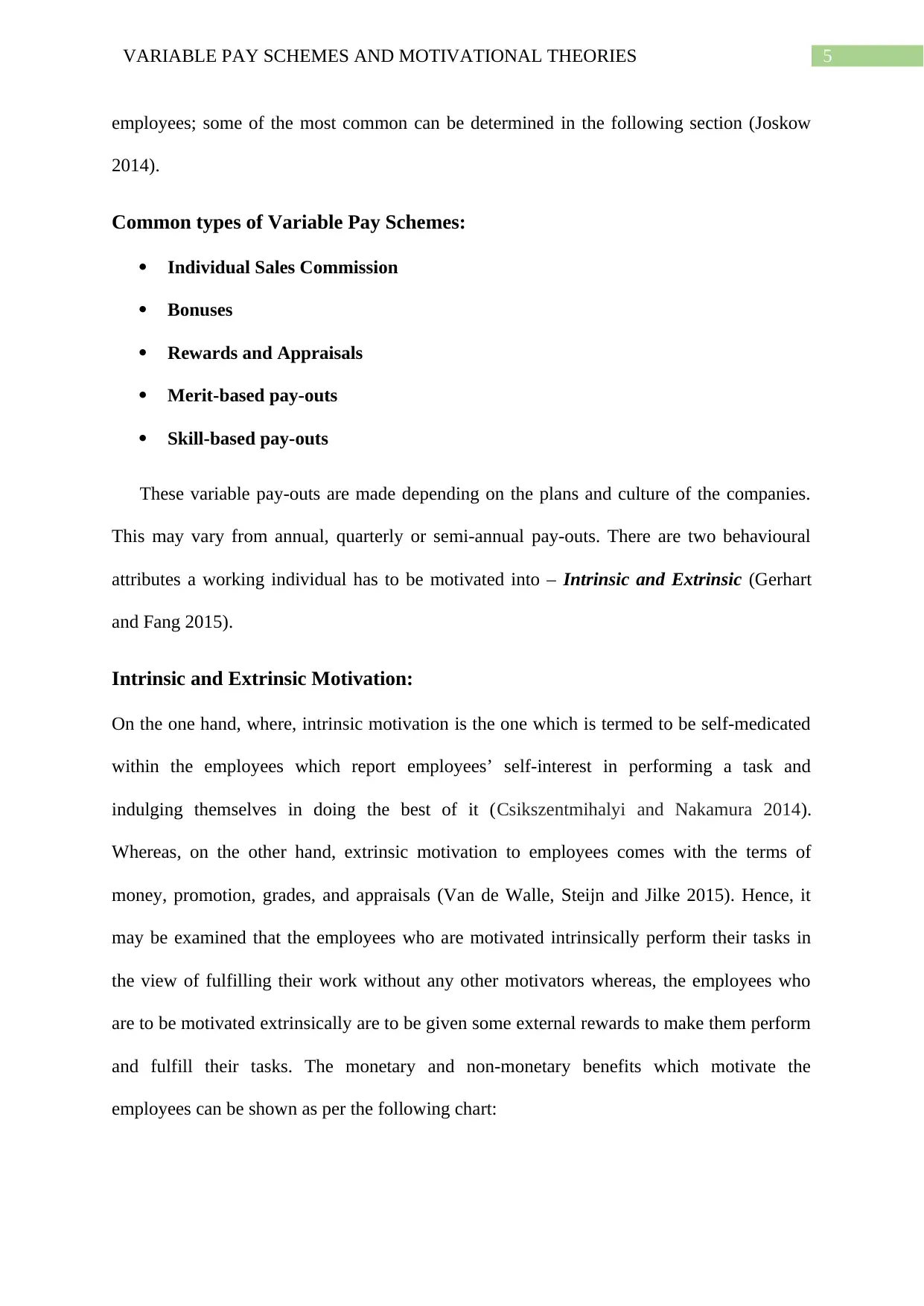
5VARIABLE PAY SCHEMES AND MOTIVATIONAL THEORIES
employees; some of the most common can be determined in the following section (Joskow
2014).
Common types of Variable Pay Schemes:
Individual Sales Commission
Bonuses
Rewards and Appraisals
Merit-based pay-outs
Skill-based pay-outs
These variable pay-outs are made depending on the plans and culture of the companies.
This may vary from annual, quarterly or semi-annual pay-outs. There are two behavioural
attributes a working individual has to be motivated into – Intrinsic and Extrinsic (Gerhart
and Fang 2015).
Intrinsic and Extrinsic Motivation:
On the one hand, where, intrinsic motivation is the one which is termed to be self-medicated
within the employees which report employees’ self-interest in performing a task and
indulging themselves in doing the best of it (Csikszentmihalyi and Nakamura 2014).
Whereas, on the other hand, extrinsic motivation to employees comes with the terms of
money, promotion, grades, and appraisals (Van de Walle, Steijn and Jilke 2015). Hence, it
may be examined that the employees who are motivated intrinsically perform their tasks in
the view of fulfilling their work without any other motivators whereas, the employees who
are to be motivated extrinsically are to be given some external rewards to make them perform
and fulfill their tasks. The monetary and non-monetary benefits which motivate the
employees can be shown as per the following chart:
employees; some of the most common can be determined in the following section (Joskow
2014).
Common types of Variable Pay Schemes:
Individual Sales Commission
Bonuses
Rewards and Appraisals
Merit-based pay-outs
Skill-based pay-outs
These variable pay-outs are made depending on the plans and culture of the companies.
This may vary from annual, quarterly or semi-annual pay-outs. There are two behavioural
attributes a working individual has to be motivated into – Intrinsic and Extrinsic (Gerhart
and Fang 2015).
Intrinsic and Extrinsic Motivation:
On the one hand, where, intrinsic motivation is the one which is termed to be self-medicated
within the employees which report employees’ self-interest in performing a task and
indulging themselves in doing the best of it (Csikszentmihalyi and Nakamura 2014).
Whereas, on the other hand, extrinsic motivation to employees comes with the terms of
money, promotion, grades, and appraisals (Van de Walle, Steijn and Jilke 2015). Hence, it
may be examined that the employees who are motivated intrinsically perform their tasks in
the view of fulfilling their work without any other motivators whereas, the employees who
are to be motivated extrinsically are to be given some external rewards to make them perform
and fulfill their tasks. The monetary and non-monetary benefits which motivate the
employees can be shown as per the following chart:
⊘ This is a preview!⊘
Do you want full access?
Subscribe today to unlock all pages.

Trusted by 1+ million students worldwide

6VARIABLE PAY SCHEMES AND MOTIVATIONAL THEORIES
Figure 1: Monetary and Non-Monetary Benefit chart
Source: (Based on Catania and Randall 2013)
Altogether with intrinsic and extrinsic motivation, several other measurable theories
link to pay the employees for their performance level. According to the study, other theories
which relate the employee motivation and variable pay scheme are Maslow’s Hierarchy of
Needs Theory and Herzberg Motivational Theory. These theories of motivation are
explained as below:
Maslow’s Hierarchy of Needs Theory:
A theory developed by Abraham Maslow in the year 1943. This is one of the main
theories that relate to the motivation of employees. A need is a lack of something that every
employee wants and satisfying these needs is the goal. As per Maslow's theory of motivation,
the five stages which describe the psychological needs of a human that a manager needs to
motivate his staff is described in the below section (Taormina and Gao 2013):
Basic needs: According to Maslow, the basic needs that drive an individual to work
harder can be specified as below:
Figure 1: Monetary and Non-Monetary Benefit chart
Source: (Based on Catania and Randall 2013)
Altogether with intrinsic and extrinsic motivation, several other measurable theories
link to pay the employees for their performance level. According to the study, other theories
which relate the employee motivation and variable pay scheme are Maslow’s Hierarchy of
Needs Theory and Herzberg Motivational Theory. These theories of motivation are
explained as below:
Maslow’s Hierarchy of Needs Theory:
A theory developed by Abraham Maslow in the year 1943. This is one of the main
theories that relate to the motivation of employees. A need is a lack of something that every
employee wants and satisfying these needs is the goal. As per Maslow's theory of motivation,
the five stages which describe the psychological needs of a human that a manager needs to
motivate his staff is described in the below section (Taormina and Gao 2013):
Basic needs: According to Maslow, the basic needs that drive an individual to work
harder can be specified as below:
Paraphrase This Document
Need a fresh take? Get an instant paraphrase of this document with our AI Paraphraser
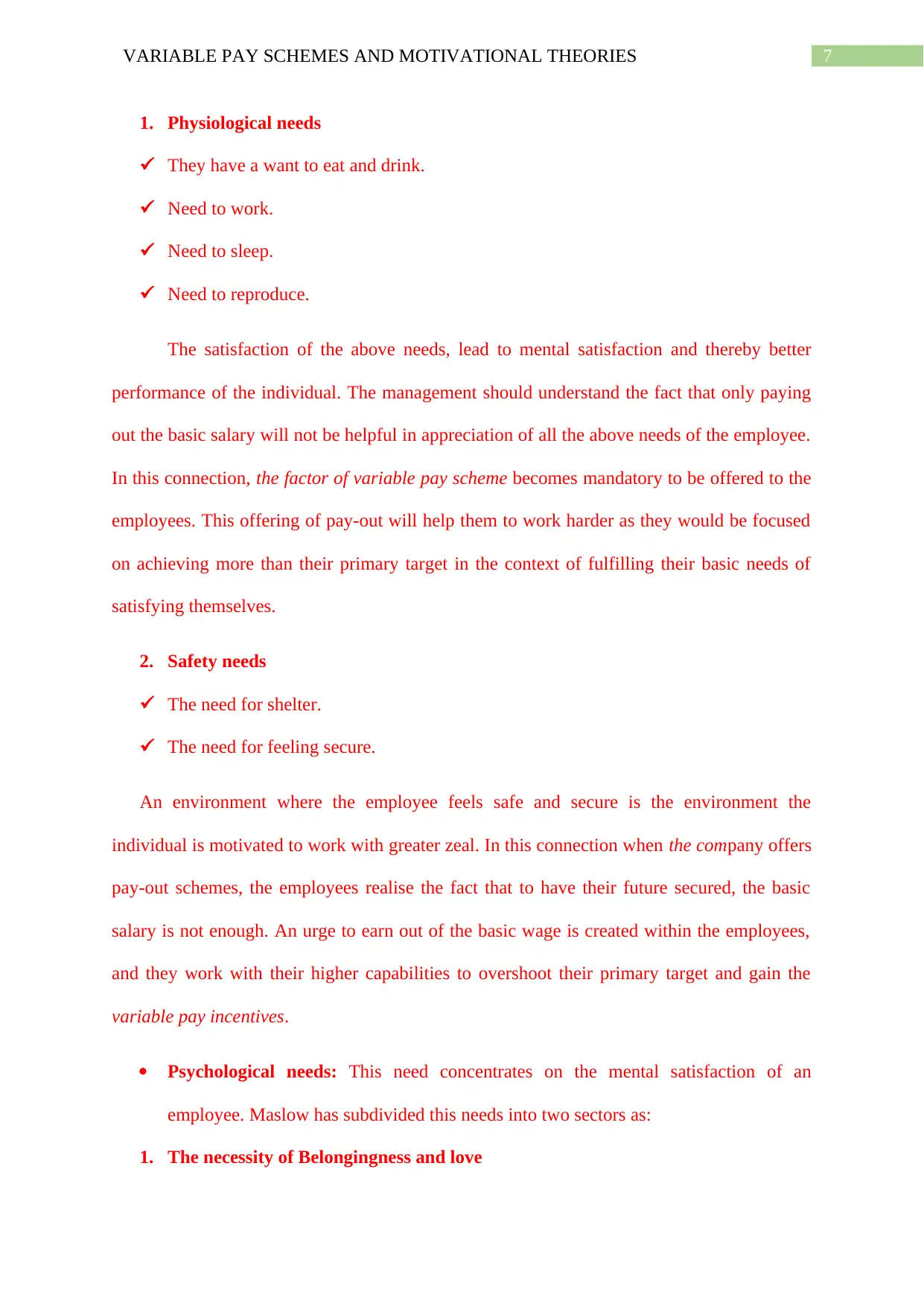
7VARIABLE PAY SCHEMES AND MOTIVATIONAL THEORIES
1. Physiological needs
They have a want to eat and drink.
Need to work.
Need to sleep.
Need to reproduce.
The satisfaction of the above needs, lead to mental satisfaction and thereby better
performance of the individual. The management should understand the fact that only paying
out the basic salary will not be helpful in appreciation of all the above needs of the employee.
In this connection, the factor of variable pay scheme becomes mandatory to be offered to the
employees. This offering of pay-out will help them to work harder as they would be focused
on achieving more than their primary target in the context of fulfilling their basic needs of
satisfying themselves.
2. Safety needs
The need for shelter.
The need for feeling secure.
An environment where the employee feels safe and secure is the environment the
individual is motivated to work with greater zeal. In this connection when the company offers
pay-out schemes, the employees realise the fact that to have their future secured, the basic
salary is not enough. An urge to earn out of the basic wage is created within the employees,
and they work with their higher capabilities to overshoot their primary target and gain the
variable pay incentives.
Psychological needs: This need concentrates on the mental satisfaction of an
employee. Maslow has subdivided this needs into two sectors as:
1. The necessity of Belongingness and love
1. Physiological needs
They have a want to eat and drink.
Need to work.
Need to sleep.
Need to reproduce.
The satisfaction of the above needs, lead to mental satisfaction and thereby better
performance of the individual. The management should understand the fact that only paying
out the basic salary will not be helpful in appreciation of all the above needs of the employee.
In this connection, the factor of variable pay scheme becomes mandatory to be offered to the
employees. This offering of pay-out will help them to work harder as they would be focused
on achieving more than their primary target in the context of fulfilling their basic needs of
satisfying themselves.
2. Safety needs
The need for shelter.
The need for feeling secure.
An environment where the employee feels safe and secure is the environment the
individual is motivated to work with greater zeal. In this connection when the company offers
pay-out schemes, the employees realise the fact that to have their future secured, the basic
salary is not enough. An urge to earn out of the basic wage is created within the employees,
and they work with their higher capabilities to overshoot their primary target and gain the
variable pay incentives.
Psychological needs: This need concentrates on the mental satisfaction of an
employee. Maslow has subdivided this needs into two sectors as:
1. The necessity of Belongingness and love
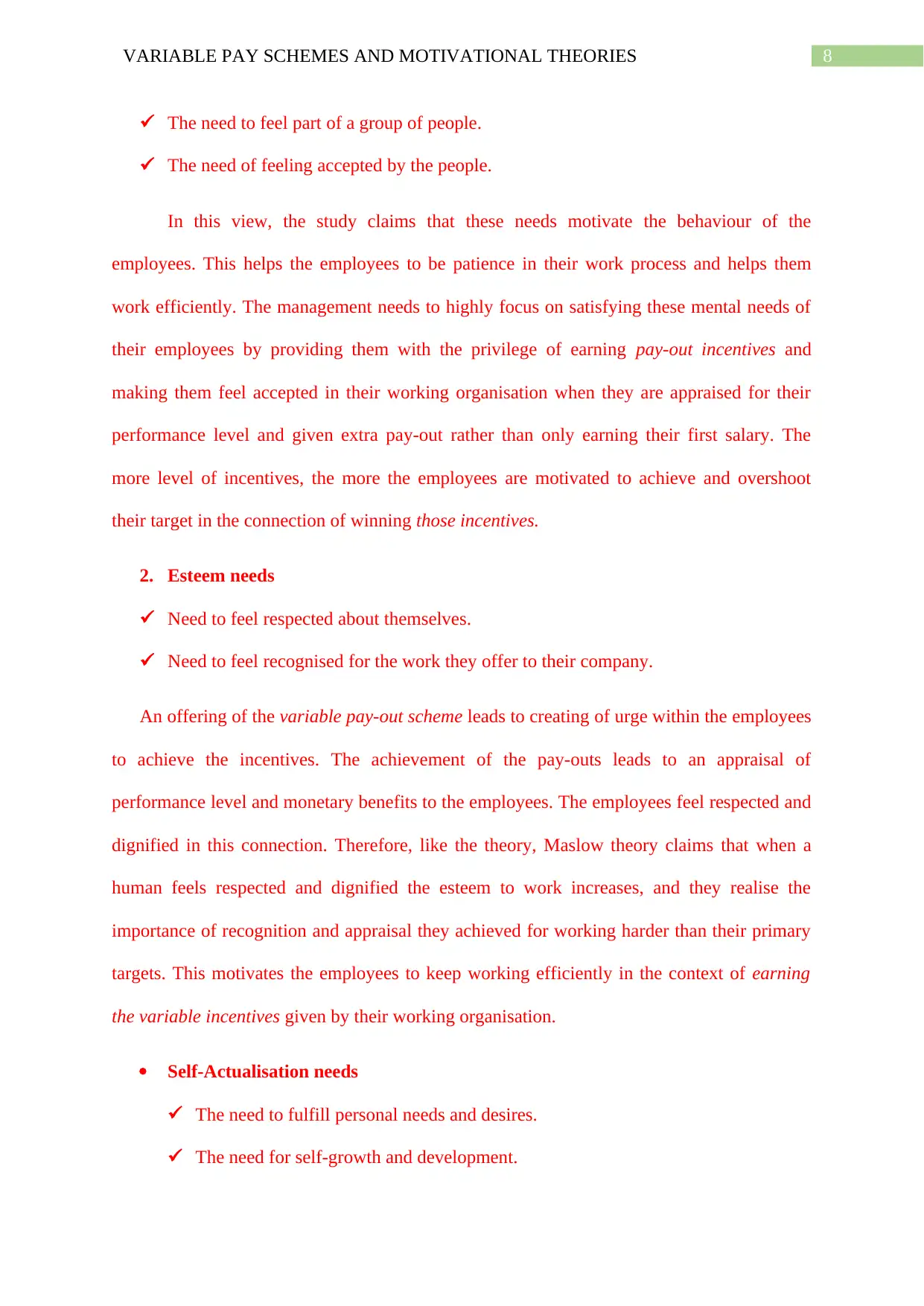
8VARIABLE PAY SCHEMES AND MOTIVATIONAL THEORIES
The need to feel part of a group of people.
The need of feeling accepted by the people.
In this view, the study claims that these needs motivate the behaviour of the
employees. This helps the employees to be patience in their work process and helps them
work efficiently. The management needs to highly focus on satisfying these mental needs of
their employees by providing them with the privilege of earning pay-out incentives and
making them feel accepted in their working organisation when they are appraised for their
performance level and given extra pay-out rather than only earning their first salary. The
more level of incentives, the more the employees are motivated to achieve and overshoot
their target in the connection of winning those incentives.
2. Esteem needs
Need to feel respected about themselves.
Need to feel recognised for the work they offer to their company.
An offering of the variable pay-out scheme leads to creating of urge within the employees
to achieve the incentives. The achievement of the pay-outs leads to an appraisal of
performance level and monetary benefits to the employees. The employees feel respected and
dignified in this connection. Therefore, like the theory, Maslow theory claims that when a
human feels respected and dignified the esteem to work increases, and they realise the
importance of recognition and appraisal they achieved for working harder than their primary
targets. This motivates the employees to keep working efficiently in the context of earning
the variable incentives given by their working organisation.
Self-Actualisation needs
The need to fulfill personal needs and desires.
The need for self-growth and development.
The need to feel part of a group of people.
The need of feeling accepted by the people.
In this view, the study claims that these needs motivate the behaviour of the
employees. This helps the employees to be patience in their work process and helps them
work efficiently. The management needs to highly focus on satisfying these mental needs of
their employees by providing them with the privilege of earning pay-out incentives and
making them feel accepted in their working organisation when they are appraised for their
performance level and given extra pay-out rather than only earning their first salary. The
more level of incentives, the more the employees are motivated to achieve and overshoot
their target in the connection of winning those incentives.
2. Esteem needs
Need to feel respected about themselves.
Need to feel recognised for the work they offer to their company.
An offering of the variable pay-out scheme leads to creating of urge within the employees
to achieve the incentives. The achievement of the pay-outs leads to an appraisal of
performance level and monetary benefits to the employees. The employees feel respected and
dignified in this connection. Therefore, like the theory, Maslow theory claims that when a
human feels respected and dignified the esteem to work increases, and they realise the
importance of recognition and appraisal they achieved for working harder than their primary
targets. This motivates the employees to keep working efficiently in the context of earning
the variable incentives given by their working organisation.
Self-Actualisation needs
The need to fulfill personal needs and desires.
The need for self-growth and development.
⊘ This is a preview!⊘
Do you want full access?
Subscribe today to unlock all pages.

Trusted by 1+ million students worldwide
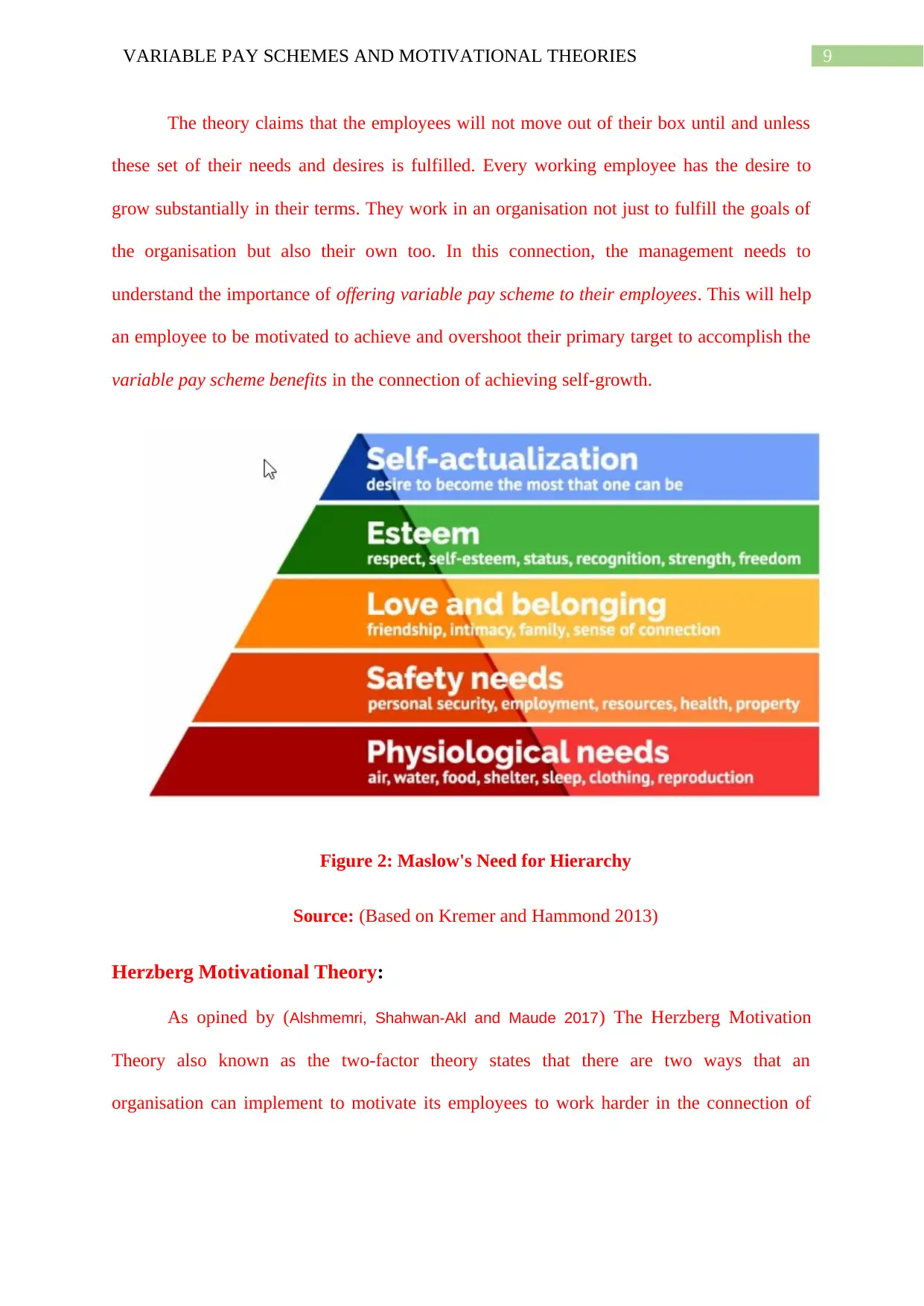
9VARIABLE PAY SCHEMES AND MOTIVATIONAL THEORIES
The theory claims that the employees will not move out of their box until and unless
these set of their needs and desires is fulfilled. Every working employee has the desire to
grow substantially in their terms. They work in an organisation not just to fulfill the goals of
the organisation but also their own too. In this connection, the management needs to
understand the importance of offering variable pay scheme to their employees. This will help
an employee to be motivated to achieve and overshoot their primary target to accomplish the
variable pay scheme benefits in the connection of achieving self-growth.
Figure 2: Maslow's Need for Hierarchy
Source: (Based on Kremer and Hammond 2013)
Herzberg Motivational Theory:
As opined by (Alshmemri, Shahwan-Akl and Maude 2017) The Herzberg Motivation
Theory also known as the two-factor theory states that there are two ways that an
organisation can implement to motivate its employees to work harder in the connection of
The theory claims that the employees will not move out of their box until and unless
these set of their needs and desires is fulfilled. Every working employee has the desire to
grow substantially in their terms. They work in an organisation not just to fulfill the goals of
the organisation but also their own too. In this connection, the management needs to
understand the importance of offering variable pay scheme to their employees. This will help
an employee to be motivated to achieve and overshoot their primary target to accomplish the
variable pay scheme benefits in the connection of achieving self-growth.
Figure 2: Maslow's Need for Hierarchy
Source: (Based on Kremer and Hammond 2013)
Herzberg Motivational Theory:
As opined by (Alshmemri, Shahwan-Akl and Maude 2017) The Herzberg Motivation
Theory also known as the two-factor theory states that there are two ways that an
organisation can implement to motivate its employees to work harder in the connection of
Paraphrase This Document
Need a fresh take? Get an instant paraphrase of this document with our AI Paraphraser
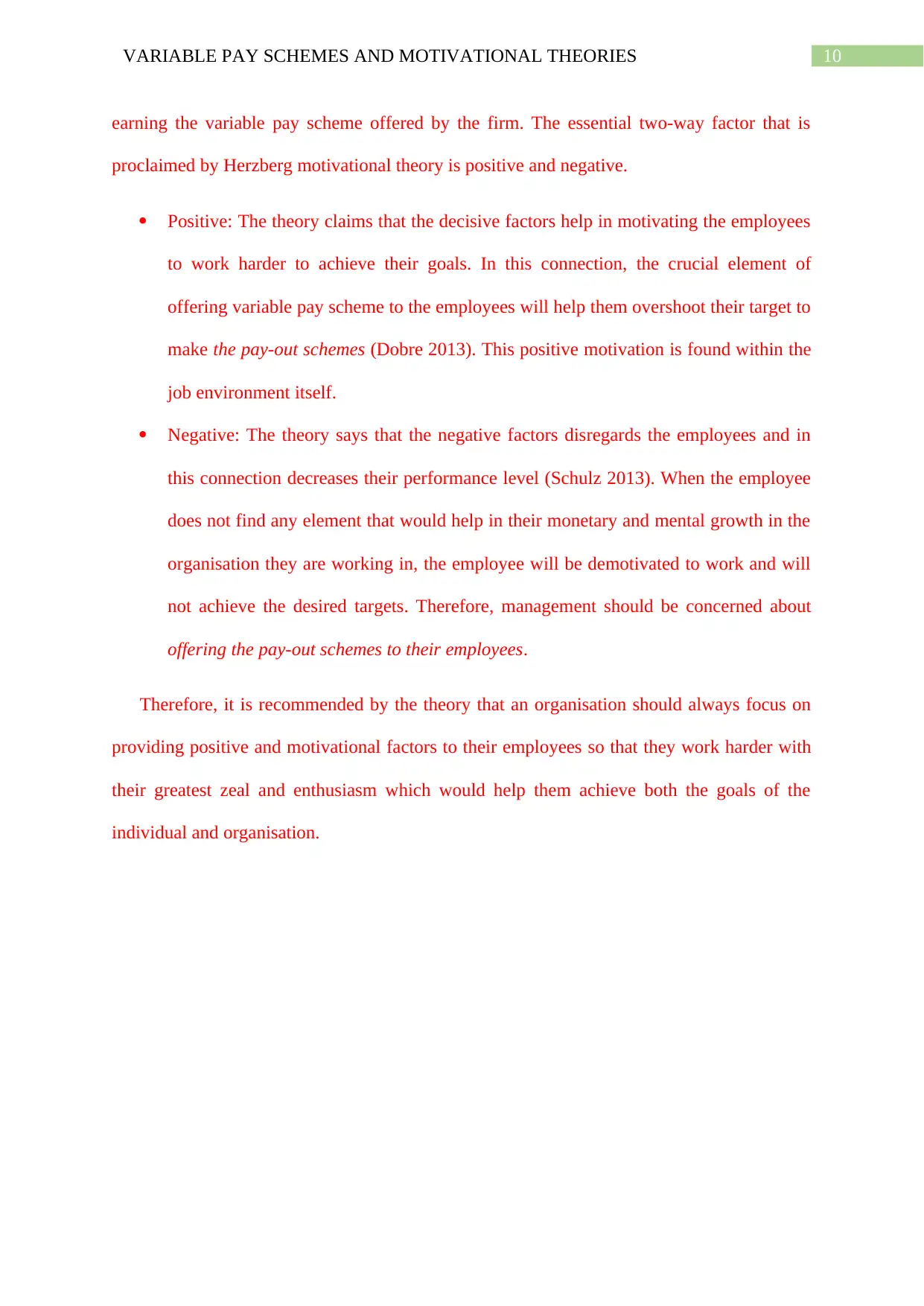
10VARIABLE PAY SCHEMES AND MOTIVATIONAL THEORIES
earning the variable pay scheme offered by the firm. The essential two-way factor that is
proclaimed by Herzberg motivational theory is positive and negative.
Positive: The theory claims that the decisive factors help in motivating the employees
to work harder to achieve their goals. In this connection, the crucial element of
offering variable pay scheme to the employees will help them overshoot their target to
make the pay-out schemes (Dobre 2013). This positive motivation is found within the
job environment itself.
Negative: The theory says that the negative factors disregards the employees and in
this connection decreases their performance level (Schulz 2013). When the employee
does not find any element that would help in their monetary and mental growth in the
organisation they are working in, the employee will be demotivated to work and will
not achieve the desired targets. Therefore, management should be concerned about
offering the pay-out schemes to their employees.
Therefore, it is recommended by the theory that an organisation should always focus on
providing positive and motivational factors to their employees so that they work harder with
their greatest zeal and enthusiasm which would help them achieve both the goals of the
individual and organisation.
earning the variable pay scheme offered by the firm. The essential two-way factor that is
proclaimed by Herzberg motivational theory is positive and negative.
Positive: The theory claims that the decisive factors help in motivating the employees
to work harder to achieve their goals. In this connection, the crucial element of
offering variable pay scheme to the employees will help them overshoot their target to
make the pay-out schemes (Dobre 2013). This positive motivation is found within the
job environment itself.
Negative: The theory says that the negative factors disregards the employees and in
this connection decreases their performance level (Schulz 2013). When the employee
does not find any element that would help in their monetary and mental growth in the
organisation they are working in, the employee will be demotivated to work and will
not achieve the desired targets. Therefore, management should be concerned about
offering the pay-out schemes to their employees.
Therefore, it is recommended by the theory that an organisation should always focus on
providing positive and motivational factors to their employees so that they work harder with
their greatest zeal and enthusiasm which would help them achieve both the goals of the
individual and organisation.
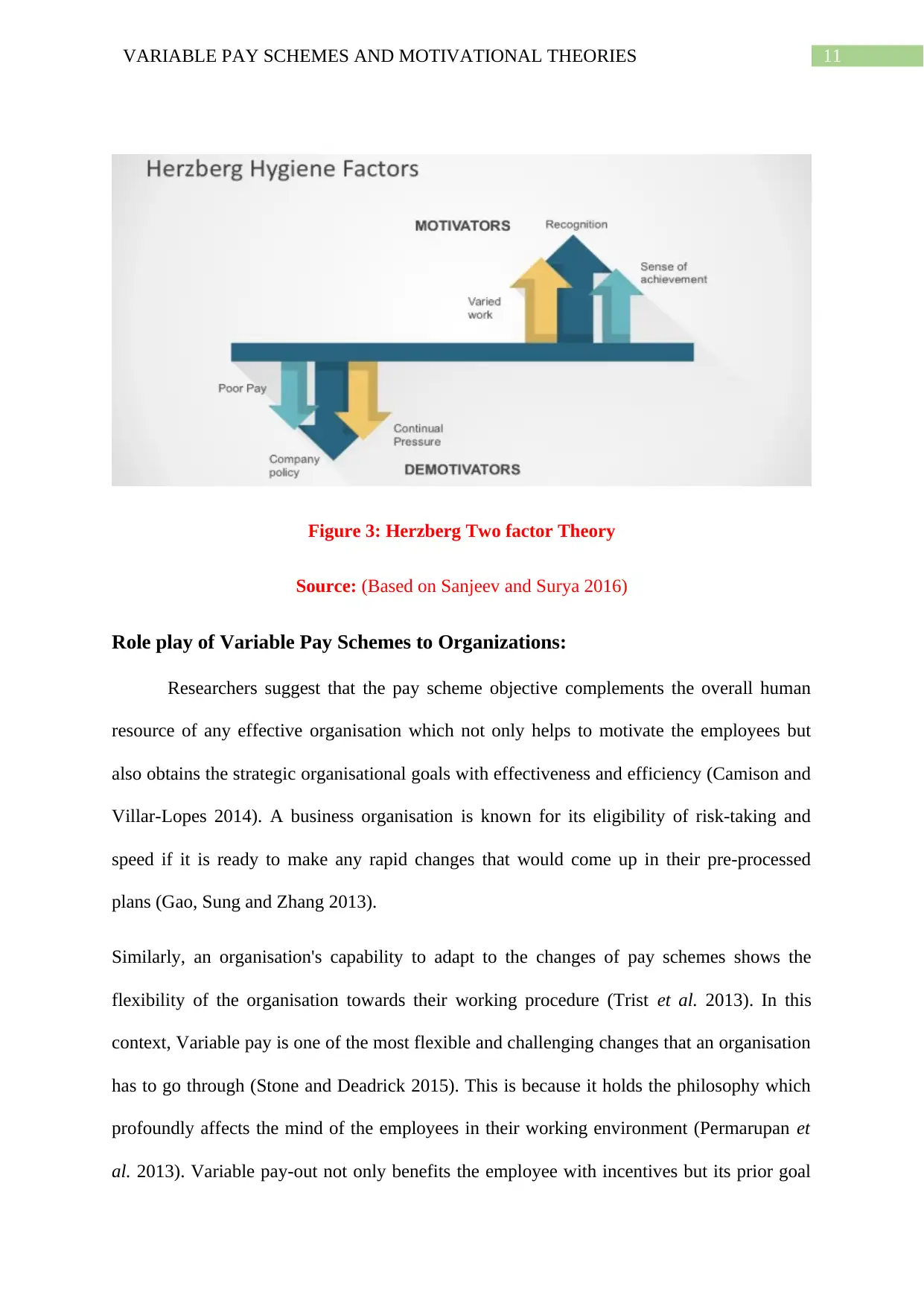
11VARIABLE PAY SCHEMES AND MOTIVATIONAL THEORIES
Figure 3: Herzberg Two factor Theory
Source: (Based on Sanjeev and Surya 2016)
Role play of Variable Pay Schemes to Organizations:
Researchers suggest that the pay scheme objective complements the overall human
resource of any effective organisation which not only helps to motivate the employees but
also obtains the strategic organisational goals with effectiveness and efficiency (Camison and
Villar-Lopes 2014). A business organisation is known for its eligibility of risk-taking and
speed if it is ready to make any rapid changes that would come up in their pre-processed
plans (Gao, Sung and Zhang 2013).
Similarly, an organisation's capability to adapt to the changes of pay schemes shows the
flexibility of the organisation towards their working procedure (Trist et al. 2013). In this
context, Variable pay is one of the most flexible and challenging changes that an organisation
has to go through (Stone and Deadrick 2015). This is because it holds the philosophy which
profoundly affects the mind of the employees in their working environment (Permarupan et
al. 2013). Variable pay-out not only benefits the employee with incentives but its prior goal
Figure 3: Herzberg Two factor Theory
Source: (Based on Sanjeev and Surya 2016)
Role play of Variable Pay Schemes to Organizations:
Researchers suggest that the pay scheme objective complements the overall human
resource of any effective organisation which not only helps to motivate the employees but
also obtains the strategic organisational goals with effectiveness and efficiency (Camison and
Villar-Lopes 2014). A business organisation is known for its eligibility of risk-taking and
speed if it is ready to make any rapid changes that would come up in their pre-processed
plans (Gao, Sung and Zhang 2013).
Similarly, an organisation's capability to adapt to the changes of pay schemes shows the
flexibility of the organisation towards their working procedure (Trist et al. 2013). In this
context, Variable pay is one of the most flexible and challenging changes that an organisation
has to go through (Stone and Deadrick 2015). This is because it holds the philosophy which
profoundly affects the mind of the employees in their working environment (Permarupan et
al. 2013). Variable pay-out not only benefits the employee with incentives but its prior goal
⊘ This is a preview!⊘
Do you want full access?
Subscribe today to unlock all pages.

Trusted by 1+ million students worldwide
1 out of 21
Related Documents
Your All-in-One AI-Powered Toolkit for Academic Success.
+13062052269
info@desklib.com
Available 24*7 on WhatsApp / Email
![[object Object]](/_next/static/media/star-bottom.7253800d.svg)
Unlock your academic potential
Copyright © 2020–2025 A2Z Services. All Rights Reserved. Developed and managed by ZUCOL.





